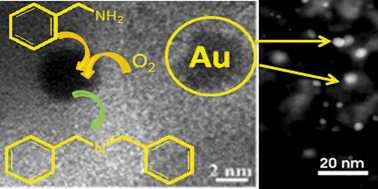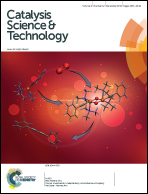New multicomponent catalysts for the selective aerobic oxidative condensation of benzylamine to N-benzylidenebenzylamine†
Abstract
Aerobic oxidative condensation of benzylamine to N-benzylidenebenzylamine was carried out on new gold-based catalysts using as support bimodal UVM-7-like mesoporous silica containing Ni and Ce (or Sn) as oxide nanodomains partially embedded inside the mesoporous UVM-7 silica walls. These nanodomains acted as effective and stable inorganic anchors favoring the nucleation, growth and stability of supported gold particles. Following the atrane method (a “one-pot” strategy able to harmonize the hydrolytic reactivity of different heteroelements through the use of complexes containing triethanolamine-derived ligands (atranes) as precursors) the stability of the oxide nanodomains during oxidation and thermal treatments was ensured. The catalysts were prepared using a two-step synthesis in which gold was incorporated through impregnation of previously synthesized bimodal porous silicas containing different heteroelements trapped by the silica mesostructure. The versatility of the preparative approach allowed the high surface area and accessibility of mesoporous silica and also an easy and homogeneous inclusion of heteroelements in one pot. Aerobic oxidative condensation of benzylamine on these catalysts occurred selectively only with the formation of N-benzylidenebenzylamine. While selectivity was total, the productivities (molproduct gcat−1 h−1) varied in a wide range as a function of catalyst composition (chemical composition and atomic ratios of the constitutive support elements). The catalytic behavior was merely controlled by the size of gold particles, but the support also exerts an influence. The best results were obtained on the mesoporous Au/Ce60–Ni10–UVM-7 catalyst having a 0.97(wt.%) gold content (in the form of nanoparticles of ca. 4 nm) and preserving a relatively high surface area (566 m2 g−1) and pore volume (0.91 cm3 g−1). The comparison with the individual or bicomponent catalysts led to the conclusion of a cooperative interaction between the catalyst components. However, gold itself exhibits a higher activity than the promoters or co-catalysts (i.e. phases containing Ni and/or Ce).


 Please wait while we load your content...
Please wait while we load your content...